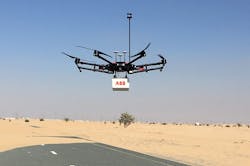Drones are finding more and more applications in industry, whether inspecting refineries and flare stacks or solar panels and wind turbines. Many applications have relied on visual technologies, attaching cameras to drones to get photographic evidence of cracks or corrosion, for example. This week at ABB Customer World in Houston, ABB has released an analyzer that combines laser absorption techniques with drone mobility to quickly gather much more precise, quantitative information to pinpoint leaks in gas pipelines.
Drones carrying cameras are being used for a number of inspection applications, but those inspections are inherently qualitative, not quantitative, explained Doug Baer, president of Los Gatos Research and global product line manager for laser analyzers at ABB. “Our technology is inherently quantitative, and it does so with parts-per-billion precision. We can determine small excursions around a baseline of methane,” he said, adding that it not only analyzes concentration, but can calculate transmission rates as well.
The ABB Ability mobile gas leak detection system uses cavity-enhanced absorption spectroscopy to detect methane and ethane with a sensitivity more than 1,000 times higher than conventional leak detection tools. The off-axis integrated cavity output spectroscopy (OA-ICOS) can quickly distinguish deviations from the typical 1,800 ppb (and growing) methane levels in our atmosphere. Measuring ethane (only found in natural gas) along with the methane (which can come from a variety of source, including farm animals) enables the identification of methane emissions specifically caused by gas pipeline leakage.
This technology has been available from ABB previously for use in vehicles typically sent to city streets and neighborhoods to check distribution pipelines, and handheld devices that can further pinpoint the leak. The new capability to put the detection system on a drone lets it move faster, to more remote areas. Users can put the analyzer on any drone that can handle a payload of at least 3 kg, opening up possibilities for analyzing difficult-to-reach areas such as pipelines on a bridge or more off-road locations, Baer commented.
The equipment’s ability to take five measurements per second also enables the drone to fly quickly—some 20-30 mph. The analyzer makes point measurements, which enables it to measure gas levels more precisely than path average techniques, for example. “We bring air into the measurement cell using an internal vacuum pump,” Baer explained. “Measurement takes place at 5 Hz, and then the air is expelled out the back of the pump.”
The technology maps out the plume in a 3D structure in real time. “We take that 3D plume, combine it with air velocity measurements and combine it with a dispersion model to determine where the leak is coming from,” Baer said.
ABB’s analysis software automatically processes the collected methane, ethane, GPS and wind data to create an easy-to-use report in GIS-compatible or PDF formats. These reports can be used to quickly identify areas in the pipeline network that potentially have leaks. Depending on wind velocity, weather, etc., resolution is on the order of 1 m, Baer said.
All the data can then be transmitted to the cloud or to a customer’s server of choice. ABB Ability cloud storage tools enable deeper analysis, and allow quick and efficient distribution of data and reports to all stakeholders. Authorized users can view the progress of flights in real time and can act on leak reports.
“There’s been a lot of interest from service companies as well as large oil exploration and drilling companies,” Baer said of the leak detection system. “They want to be good citizens, and they want to protect their customers and staff and resources. This gives them a sensitive and effective tool to do that.”
ABB has been testing for more than a year with customers in Alaska, New York, China, France and other locations, Baer said. With the public launch this week, service providers in particular have been showing interest at the ABB Customer World exhibition, he added. For service providers that already offer leak-finding services, the drone-based detection system gives them another way to reach further and more precisely.
About the Author
Aaron Hand
Editor-in-Chief, ProFood World

Leaders relevant to this article:
